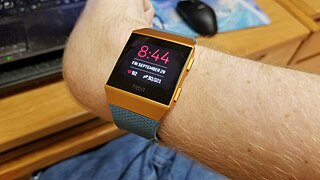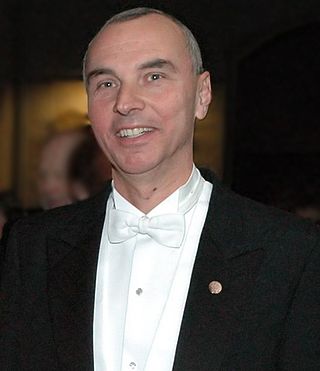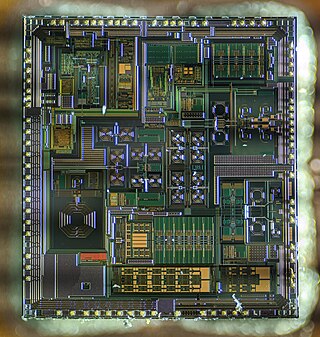Related Research Articles
Ultra-wideband is a radio technology that can use a very low energy level for short-range, high-bandwidth communications over a large portion of the radio spectrum. UWB has traditional applications in non-cooperative radar imaging. Most recent applications target sensor data collection, precise locating, and tracking. UWB support started to appear in high-end smartphones in 2019.
Motion detection is the process of detecting a change in the position of an object relative to its surroundings or a change in the surroundings relative to an object. It can be achieved by either mechanical or electronic methods. When it is done by natural organisms, it is called motion perception.

A heart rate monitor (HRM) is a personal monitoring device that allows one to measure/display heart rate in real time or record the heart rate for later study. It is largely used to gather heart rate data while performing various types of physical exercise. Measuring electrical heart information is referred to as electrocardiography.

Sensor fusion is the process of combining sensor data or data derived from disparate sources such that the resulting information has less uncertainty than would be possible when these sources were used individually. For instance, one could potentially obtain a more accurate location estimate of an indoor object by combining multiple data sources such as video cameras and WiFi localization signals. The term uncertainty reduction in this case can mean more accurate, more complete, or more dependable, or refer to the result of an emerging view, such as stereoscopic vision.
Radiolocation, also known as radiolocating or radiopositioning, is the process of finding the location of something through the use of radio waves. It generally refers to passive uses, particularly radar—as well as detecting buried cables, water mains, and other public utilities. It is similar to radionavigation, but radiolocation usually refers to passively seeking a distant object rather than actively finding one's own position; both are types of radiodetermination. Radiolocation is also used in real-time locating systems (RTLS) for tracking valuable assets.

An ion-sensitive field-effect transistor (ISFET) is a field-effect transistor used for measuring ion concentrations in solution; when the ion concentration (such as H+, see pH scale) changes, the current through the transistor will change accordingly. Here, the solution is used as the gate electrode. A voltage between substrate and oxide surfaces arises due to an ion sheath. It is a special type of MOSFET (metal–oxide–semiconductor field-effect transistor), and shares the same basic structure, but with the metal gate replaced by an ion-sensitive membrane, electrolyte solution and reference electrode. Invented in 1970, the ISFET was the first biosensor FET (BioFET).
A medical alarm is an alarm system designed to signal the presence of a hazard requiring urgent attention and to summon emergency medical personnel. Other terms for a medical alarm are Personal Emergency Response System (PERS) or medical alert. It is especially important to recognize the need to respond to situations where the person is unable to summon help.

An indoor positioning system (IPS) is a network of devices used to locate people or objects where GPS and other satellite technologies lack precision or fail entirely, such as inside multistory buildings, airports, alleys, parking garages, and underground locations.
Lee Swindlehurst is an electrical engineer who has made contributions in sensor array signal processing for radar and wireless communications, detection and estimation theory, and system identification, and has received many awards in these areas. He is currently a Professor of Electrical Engineering and Computer Science at the University of California at Irvine.

Magnetomyography (MMG) is a technique for mapping muscle activity by recording magnetic fields produced by electrical currents occurring naturally in the muscles, using arrays of SQUIDs. It has a better capability than electromyography for detecting slow or direct currents. The magnitude of the MMG signal is in the scale of pico (10−12) to femto (10−15) Tesla (T). Miniaturizing MMG offers a prospect to modernize the bulky SQUID to wearable miniaturized magnetic sensors.

Peter (Petre) Stoica is a researcher and educator in the field of signal processing and its applications to radar/sonar, communications and bio-medicine. He is a professor of Signals and Systems Modeling at Uppsala University in Sweden, and a Member of the Royal Swedish Academy of Engineering Sciences, the United States National Academy of Engineering (International Member), the Romanian Academy, the European Academy of Sciences, and the Royal Society of Sciences. He is also a Fellow of IEEE, EURASIP, IETI, and the Royal Statistical Society.
Ambient backscatter uses existing radio frequency signals, such as radio, television and mobile telephony, to transmit data without a battery or power grid connection. Each such device uses an antenna to pick up an existing signal and convert it into tens to hundreds of microwatts of electricity. It uses that power to modify and reflect the signal with encoded data. Antennas on other devices, in turn, detect that signal and can respond accordingly.

A field-effect transistor-based biosensor, also known as a biosensor field-effect transistor, field-effect biosensor (FEB), or biosensor MOSFET, is a field-effect transistor that is gated by changes in the surface potential induced by the binding of molecules. When charged molecules, such as biomolecules, bind to the FET gate, which is usually a dielectric material, they can change the charge distribution of the underlying semiconductor material resulting in a change in conductance of the FET channel. A Bio-FET consists of two main compartments: one is the biological recognition element and the other is the field-effect transistor. The BioFET structure is largely based on the ion-sensitive field-effect transistor (ISFET), a type of metal–oxide–semiconductor field-effect transistor (MOSFET) where the metal gate is replaced by an ion-sensitive membrane, electrolyte solution, and reference electrode.

AlfonsoFarinaFREng is an Italian electronic engineer and former industry manager. He is most noted for the development of the track while scan techniques for radars and generally for the development of a wide range of signal processing techniques used for sensors where tracking plays an essential role. He is author of about 1000 publications. His work was aimed to a synergistic cooperation between industry and academy.

Sergio Barbarossa is an Italian professor, engineer and inventor. He is a professor at Sapienza University of Rome, Italy.

Human presence detection is a range of technologies and methods for detecting the presence of a human body in an area of interest (AOI), or verification that computer, smartphone is operated by human. Software and hardware technologies are used for human presence detection. Unlike human sensing, that is dealing with human body only, human presence detection technologies are used to verify for safety, security or other reasons that human person, but not any other object is identified. Methods can be used for internet security authentication. These include software technologies such CAPTCHA and reCAPTCHA, as well as hardware technologies such as:

An event camera, also known as a neuromorphic camera, silicon retina or dynamic vision sensor, is an imaging sensor that responds to local changes in brightness. Event cameras do not capture images using a shutter as conventional (frame) cameras do. Instead, each pixel inside an event camera operates independently and asynchronously, reporting changes in brightness as they occur, and staying silent otherwise.

RF CMOS is a metal–oxide–semiconductor (MOS) integrated circuit (IC) technology that integrates radio-frequency (RF), analog and digital electronics on a mixed-signal CMOS RF circuit chip. It is widely used in modern wireless telecommunications, such as cellular networks, Bluetooth, Wi-Fi, GPS receivers, broadcasting, vehicular communication systems, and the radio transceivers in all modern mobile phones and wireless networking devices. RF CMOS technology was pioneered by Pakistani engineer Asad Ali Abidi at UCLA during the late 1980s to early 1990s, and helped bring about the wireless revolution with the introduction of digital signal processing in wireless communications. The development and design of RF CMOS devices was enabled by van der Ziel's FET RF noise model, which was published in the early 1960s and remained largely forgotten until the 1990s.
Fauzia Ahmad is an associate professor of electrical engineering at Temple University. Her research considers statistical signal processing and ultrasonic guided wave structural health monitoring. She serves as associate editor of the IEEE Transactions on Aerospace and Electronic Systems and Geoscience and Remote Sensing Society. She is a Fellow of the Institute of Electrical and Electronics Engineers and SPIE.
WiFi sensing uses existing Wi-Fi signals to detect events or changes such as motion, gesture recognition, and biometric measurement. WiFi sensing is a combination of Wi-Fi and radar sensing technology working in tandem to enable usage of the same Wi-Fi transceiver hardware and RF spectrum for both communication and sensing.
References
- ↑ Li, Changzhi; Lubecke, Victor M.; Boric-Lubecke, Olga; Lin, Jenshan (2013). "A Review on Recent Advances in Doppler Radar Sensors for Noncontact Healthcare Monitoring". IEEE Transactions on Microwave Theory and Techniques. 61 (5): 2046–2060. Bibcode:2013ITMTT..61.2046L. doi:10.1109/TMTT.2013.2256924. S2CID 18274335.
- ↑ Ahmad, Fauzia; Narayanan, Ram M.; Schreurs, Dominique (2015). "Application of Radar to Remote Patient Monitoring and Eldercare". IET Radar, Sonar & Navigation. 9 (2): 115. doi: 10.1049/iet-rsn.2015.0038 . S2CID 122131216.
- ↑ Soldovieri, Francesco; Catapano, Ilaria; Crocco, Lorenzo; Anishchenko, Lesya N.; Ivashov, Sergey I. (2012). "A Feasibility Study for Life Signs Monitoring via a Continuous-Wave Radar". International Journal of Antennas and Propagation. 2012: 1–5. doi: 10.1155/2012/420178 .
- ↑ Xu, Hui; Li, Bangyu; Che, Xinsheng; Ren, Jian (2011). "Analyzing the Effect and Selecting the Parameter of Bioradar Antenna for Measurement". Advanced Research on Computer Education, Simulation and Modeling. Communications in Computer and Information Science. Vol. 176. pp. 451–456. doi:10.1007/978-3-642-21802-6_73. ISBN 978-3-642-21801-9.
- ↑ Will, Christoph; Shi, Kilin; Schellenberger, Sven; Steigleder, Tobias; Michler, Fabian; Weigel, Robert; Ostgathe, Christoph; Koelpin, Alexander (2017). "Local Pulse Wave Detection Using Continuous Wave Radar Systems". IEEE Journal of Electromagnetics, RF and Microwaves in Medicine and Biology. 1 (2): 81–89. doi:10.1109/JERM.2017.2766567. S2CID 20747916.
- 1 2 Will, Christoph; Shi, Kilin; Schellenberger, Sven; Steigleder, Tobias; Michler, Fabian; Fuchs, Jonas; Weigel, Robert; Ostgathe, Christoph; Koelpin, Alexander (2018). "Radar-Based Heart Sound Detection". Scientific Reports. 8 (1): 11551. Bibcode:2018NatSR...811551W. doi:10.1038/s41598-018-29984-5. PMC 6070547 . PMID 30068983.
- ↑ Shi, Kilin; Schellenberger, Sven; Will, Christoph; Steigleder, Tobias; Michler, Fabian; Fuchs, Jonas; Weigel, Robert; Ostgathe, Christoph; Koelpin, Alexander (2020-02-13). "A dataset of radar-recorded heart sounds and vital signs including synchronised reference sensor signals". Scientific Data. 7 (1): 50. Bibcode:2020NatSD...7...50S. doi: 10.1038/s41597-020-0390-1 . ISSN 2052-4463. PMC 7018953 . PMID 32054854.
- ↑ Shi, Kilin; Schellenberger, Sven; Michler, Fabian; Steigleder, Tobias; Malessa, Anke; Lurz, Fabian; Ostgathe, Christoph; Weigel, Robert; Koelpin, Alexander (2020). "Automatic Signal Quality Index Determination of Radar-Recorded Heart Sound Signals Using Ensemble Classification". IEEE Transactions on Biomedical Engineering. 67 (3): 773–785. doi:10.1109/TBME.2019.2921071. ISSN 1558-2531. PMID 31180834. S2CID 184484379.
- ↑ Immoreev, Igor Y. (2010). "Practical applications of UWB technology". IEEE Aerospace and Electronic Systems Magazine. 25 (2): 36–42. doi:10.1109/MAES.2010.5442175. S2CID 45543286.
- ↑ Wang, Fu-Kang; Horng, Tzyy-Sheng; Peng, Kang-Chun; Jau, Je-Kuan; Li, Jian-Yu; Chen, Cheng-Chung (2013). "Detection of Concealed Individuals Based on Their Vital Signs by Using a See-Through-Wall Imaging System with a Self-Injection-Locked Radar". IEEE Transactions on Microwave Theory and Techniques. 61 (1): 696–704. Bibcode:2013ITMTT..61..696W. doi:10.1109/TMTT.2012.2228223. S2CID 16853266.
- ↑ Otsu, Mitsugu; Nakamura, Ryohei; Kajiwara, Akihiro (2011). "Remote respiration monitoring sensor using stepped-FM". 2011 IEEE Sensors Applications Symposium. pp. 155–158. doi:10.1109/SAS.2011.5739784. ISBN 978-1-4244-8063-0. S2CID 16557750.
- ↑ S.I. Ivashov, V.V. Razevig, A.P. Sheyko, I.A. Vasilyev, "Detection of Human Breathing and Heartbeat by Remote Radar", Progress in Electromagnetics Research Symposium (PIERS 2004), March 28–31, 2004, Pisa, Italy, pp. 663-666.
- ↑ Alekhin, Maksim; Anishchenko, Lesya; Tataraidze, Alexander; Ivashov, Sergey; Parashin, Vladimir; Dyachenko, Alexander (2013). "Comparison of Bioradiolocation and Respiratory Plethysmography Signals in Time and Frequency Domains on the Base of Cross-Correlation and Spectral Analysis". International Journal of Antennas and Propagation. 2013: 1–6. doi: 10.1155/2013/410692 . ISSN 1687-5869.
- ↑ "Xaver 400 Compact, Tactical Through-Wall Imaging System". Camero-tech.com. Archived from the original on 2014-04-03. Retrieved 2014-03-13.
- ↑ Zetik, Rudolf; Crabbe, Stephen; Krajnak, Jozef; Peyerl, Peter; Sachs, Jürgen; Thomä, Reiner (2006). "Detection and localization of persons behind obstacles using M-sequence through-the-wall radar". In Carapezza, Edward M (ed.). Sensors, and Command, Control, Communications, and Intelligence (C3I) Technologies for Homeland Security and Homeland Defense V. Vol. 6201. pp. 62010I. doi:10.1117/12.667989. S2CID 12892463.
- ↑ M. Pieraccini, G. Grazzini, D. Dei, C. Atzeni, GPR system to locate survivors of natural disasters // Proc. Of 12th International Conference on ground penetrating radar, June 16–19, 2008, Birmingham, UK.
- ↑ Staderini, E.M. (2002). "UWB radars in medicine". IEEE Aerospace and Electronic Systems Magazine. 17: 13–18. doi:10.1109/62.978359.
- ↑ Alekhin, Maksim; Anishchenko, Lesya; Tataraidze, Alexander; Ivashov, Sergey; Parashin, Vladimir; Korostovtseva, Lyudmila; Sviryaev, Yurii; Bogomolov, Alexey (2013). "A Novel Method for Recognition of Bioradiolocation Signal Breathing Patterns for Noncontact Screening of Sleep Apnea Syndrome". International Journal of Antennas and Propagation. 2013: 1–8. doi: 10.1155/2013/969603 . ISSN 1687-5869.
- ↑ Alekhin, M. D.; Anishchenko, L. N.; Zhuravlev, A. V.; Ivashov, S. I.; Korostovtseva, L. S.; Sviryaev, Y. V.; Konradi, A. O.; Parashin, V. B.; Bogomolov, A. V. (2013). "Estimation of Information Value of Diagnostic Data Obtained by Bioradiolocation Pneumography in Non-contact Screening of Sleep Apnea Syndrome". Biomedical Engineering. 47 (2): 96–99. doi:10.1007/s10527-013-9343-8. S2CID 12473547.
- ↑ Shi, Kilin; Steigleder, Tobias; Schellenberger, Sven; Michler, Fabian; Malessa, Anke; Lurz, Fabian; Rohleder, Nicolas; Ostgathe, Christoph; Weigel, Robert; Koelpin, Alexander (2021-02-04). "Contactless analysis of heart rate variability during cold pressor test using radar interferometry and bidirectional LSTM networks". Scientific Reports. 11 (1): 3025. Bibcode:2021NatSR..11.3025S. doi: 10.1038/s41598-021-81101-1 . ISSN 2045-2322. PMC 7862409 . PMID 33542260.
- ↑ Anishchenko, L. N.; Bugaev, A. S.; Ivashov, S. I.; Zhuravlev, A. V. (2011). "Bioradar for monitoring of human adaptive capabilities". 2011 XXXTH URSI General Assembly and Scientific Symposium. pp. 1–4. doi:10.1109/URSIGASS.2011.6051322. ISBN 978-1-4244-5117-3. S2CID 28329694.
- ↑ Application of Bioradiolocation for Estimation of the Laboratory Animals' Movement Activity /L.N. Anishchenko, A.S. Bugaev, S.I. Ivashov, I.A. Vasiliev //PIERS Online. 2009. Vol. 5, No. 6. P.551 – 554.
- ↑ "Kardian - ABOUT". Kardian. Archived from the original on 2018-06-18. Retrieved 2018-06-18.